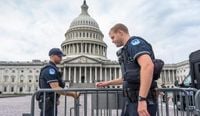As the clock ticks down to a critical budget deadline, Washington is once again gripped by the specter of a government shutdown—and this time, the stakes for federal workers are particularly high. With September 30, 2025, looming, the White House has issued a stern directive to federal agencies: prepare for mass firings if Congress fails to strike a deal. The Office of Management and Budget (OMB) sent a memo on September 25, instructing agencies to draft "reduction in force" plans for programs that would lose funding if lawmakers cannot agree on a new budget. According to BBC and The Hill, these firings could become permanent for employees working on projects that lack alternative funding sources and do not align with the President’s priorities.
The memo, first reported by Politico, specifies that agencies must consider dismissals only if three conditions are met: discretionary funding lapses on October 1, there is no alternative funding available, and the affected programs are not consistent with the President’s agenda. The OMB further instructed agencies to revise their reduction plans after any shutdown ends, retaining only the "minimal number" of staff needed to keep essential functions running. The message is clear: if Congress doesn’t act, thousands of federal workers could be out of a job for good.
The budget standoff comes as negotiations between President Trump and Democratic leaders have ground to a halt. On September 23, President Trump abruptly canceled a meeting with Senate Minority Leader Chuck Schumer and House Minority Leader Hakeem Jeffries, dismissing their demands as "unserious and ridiculous." On social media, Trump wrote, "I have decided that no meeting with their Congressional Leaders could possibly be productive." The OMB memo, meanwhile, accused congressional Democrats of blocking a "clean" continuing resolution and demanding $1 trillion in new spending, a move the administration labeled as "insane."
House Republicans, with the support of one Democrat, had previously passed a short-term measure to keep the government funded until November 20. However, Senate Democrats blocked the bill, instead proposing their own plan to restore healthcare funding after deep cuts were made by Trump’s July "One, Big Beautiful Bill." That legislation slashed Medicaid, the vital healthcare program relied on by millions of disabled and low-income Americans. Democrats argue that these cuts are unacceptable, and they want to see funding restored before agreeing to any stopgap measure.
As the clock runs out, the White House claims it remains "hopeful that Democrats in Congress will not trigger a shutdown and the steps outlined above will not be necessary." But the threat of permanent job losses is hanging over the heads of federal workers, many of whom have already seen their livelihoods disrupted by the administration’s aggressive cost-cutting initiatives.
Indeed, since taking office, President Trump has made no secret of his desire to shrink the federal workforce. Thousands of employees have already been dismissed through the Department of Government Efficiency (DOGE), a campaign that was initially led by former Trump adviser Elon Musk. While mass firings slowed after Musk’s departure in May, the administration has continued to make "adjustments" to its workforce, as a spokesperson for the General Services Administration (GSA) told Reuters.
On September 24, the GSA offered 400 real estate management workers—previously let go as part of the efficiency drive—the chance to return to their roles. Simultaneously, 126 other employees at the GSA’s Public Buildings Service were being fired, highlighting the ongoing volatility for federal workers. The affected team is responsible for negotiating leases, overseeing renovations, and managing government property, crucial tasks that keep the machinery of government running smoothly. The GSA also announced plans to create a new team to help agencies consolidate and relocate offices, a nod to President Trump’s campaign pledge to move tens of thousands of federal employees out of the Washington, D.C. region. As of this year, more than 80% of federal employees already work outside the capital, according to the Office of Personnel Management.
The human impact of these policies is stark. Jessie Beck, a fisheries biologist with the National Oceanic and Atmospheric Administration, lost her job in the Trump administration’s mass purge of probationary employees earlier this year. After more than a decade in nonprofit conservation work, Beck had joined NOAA for a more direct role in solving environmental challenges. She was ten months into her job when she was fired on February 27. "Immediately, I would return to my job, as would many, many others," Beck told NPR. "We loved our jobs. We worked really hard to be there. And a lot of us have found short-term or other work to fill that gap. But a lot of us have also taken pay cuts to do so and really have suffered a lot of damage to our careers."
Beck’s story is echoed by other federal workers caught up in the administration’s sweeping employment actions. A former health care technology expert at the Centers for Medicare & Medicaid Services, who requested anonymity, described a fruitless job search and a frustrating battle for unemployment benefits. "Nobody's available to talk to you. The phone gets disconnected," he said, reflecting the uncertainty and financial strain facing many former federal employees.
Legal challenges to the administration’s actions have so far provided little relief. On September 12, U.S. District Judge William Alsup ruled that the mass terminations of probationary federal employees were unlawful. However, citing Supreme Court precedents and the passage of time, Alsup declined to order reinstatement, noting that many terminated employees had "moved on with their lives and found new jobs." Beck, for her part, disputes this, saying she and others would return "immediately" if given the chance. Alsup did, however, order agencies to issue official letters clarifying that the firings were not due to performance issues—a small but meaningful gesture for those whose reputations are on the line.
The Trump administration’s approach to federal employment has also drawn judicial scrutiny in other areas. On September 24, U.S. District Judge Ana Reyes found that President Trump unlawfully fired eight inspectors general by failing to notify Congress and justify their removals, as required by the Inspector General Act of 1978. The inspectors general, who oversaw waste, fraud, and abuse at major agencies, had sued for reinstatement and back pay. While Judge Reyes acknowledged their "exceptional service" and the illegality of their dismissals, she declined to reinstate them, citing a lack of irreparable harm and the possibility that Trump could lawfully remove them with proper notice. The case is now on hold, awaiting a Supreme Court decision that could further define the president’s power to hire and fire executive branch officials.
For many federal employees, the message from Washington is clear: job security is increasingly fragile, and even a court ruling in their favor may not be enough to get their jobs back. As the budget deadline approaches, the fate of thousands hangs in the balance, their futures subject to the shifting winds of politics and the courts. The government’s power to hire and fire—once seen as a bureaucratic matter—has become a flashpoint in a broader struggle over the size, scope, and accountability of the federal workforce. With so much uncertainty, workers like Jessie Beck are left to wonder if they will ever truly have closure—or a chance to serve again.






